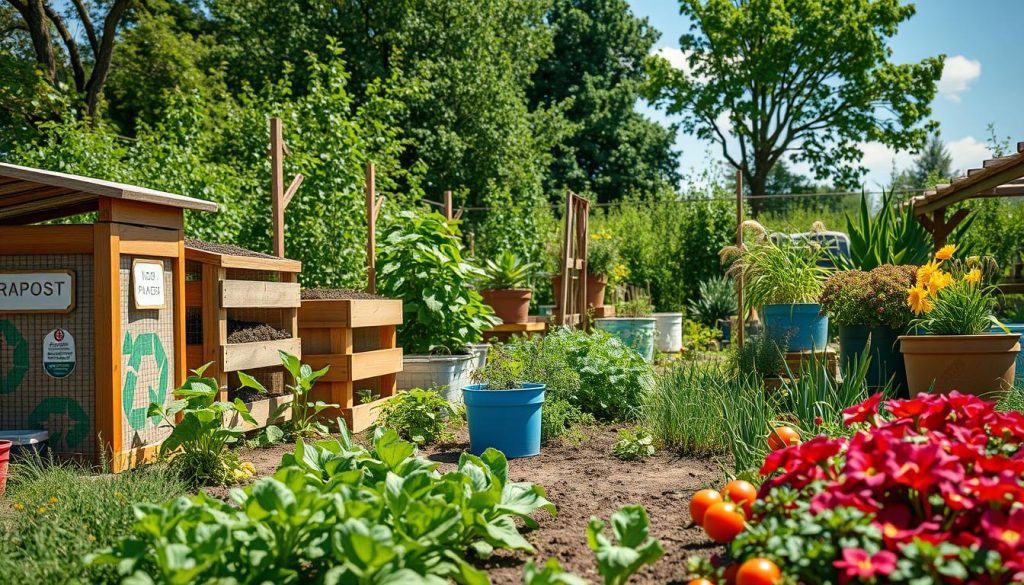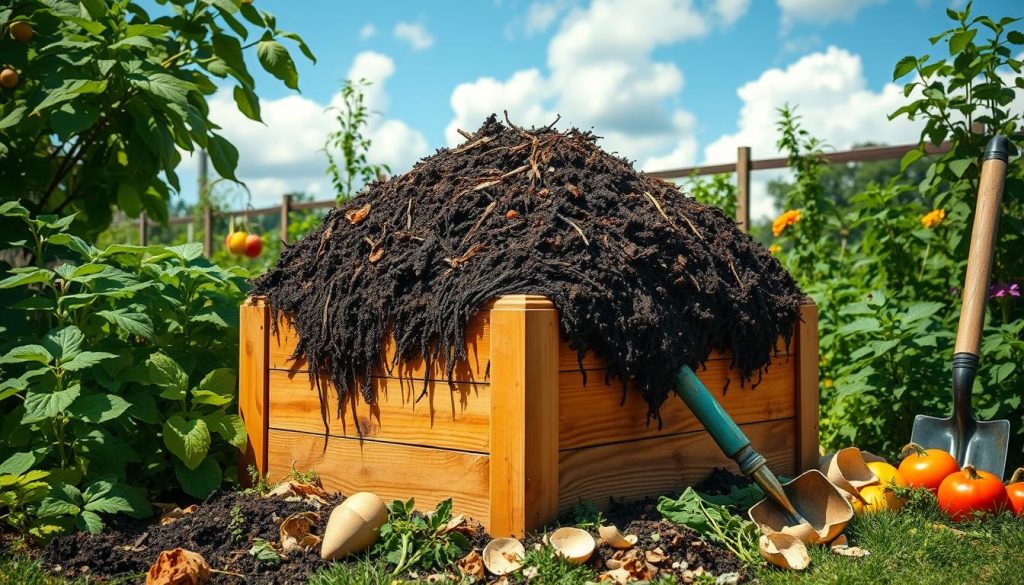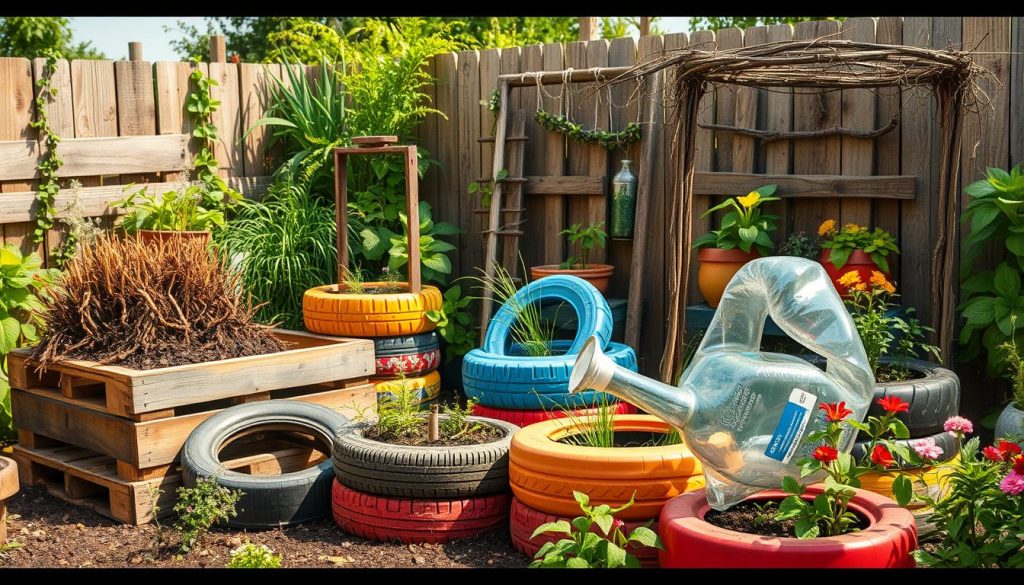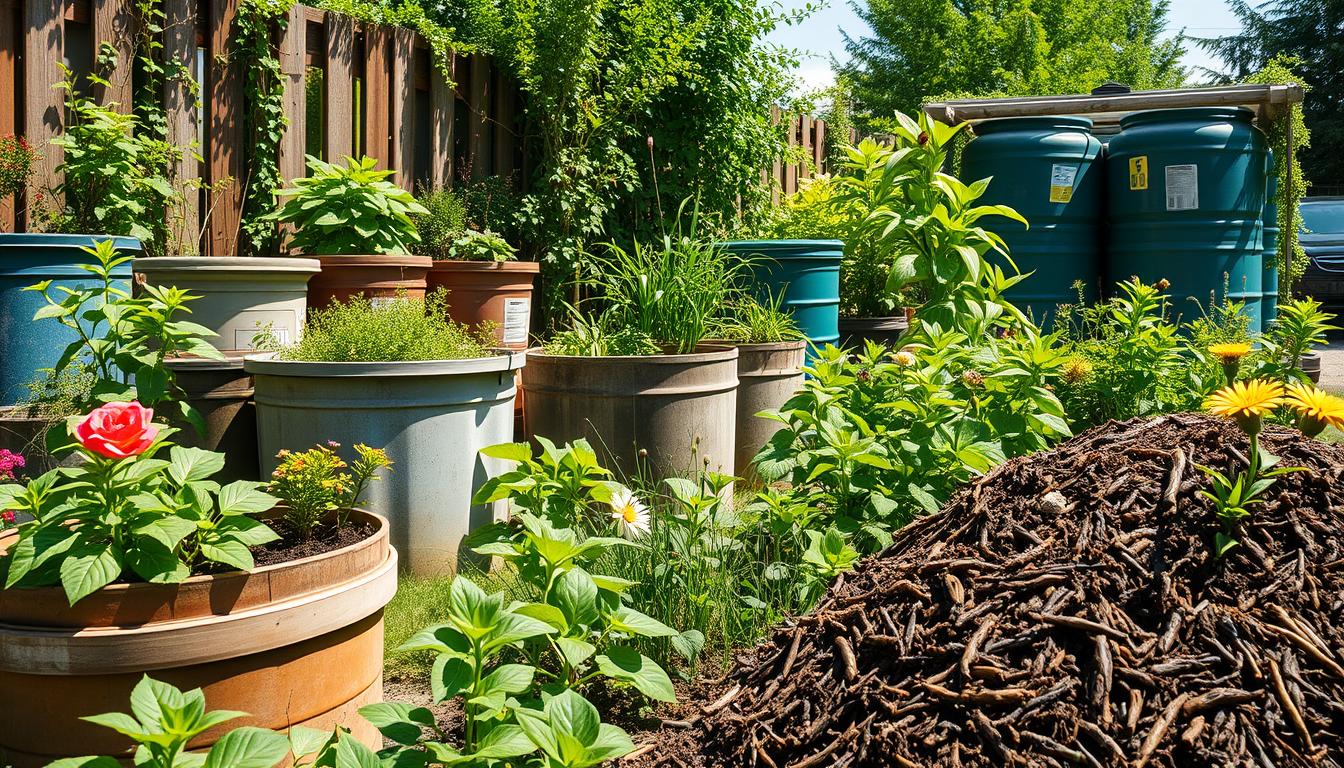Welcome to my zero-waste gardening workshop. Here, I’ll share my best tips for a sustainable garden. I’m passionate about gardening and reducing waste. That’s why I’m excited to teach you through these workshops.
I’ll show you how to plan, compost, and use waste materials. This way, you can create a stunning, eco-friendly garden. It’s great for those who want to join eco-friendly gardening workshops.
Whether you’re new to gardening or have experience, this workshop is for you. It’s a chance to make a difference for our planet. I’m looking forward to sharing my knowledge with you through these workshops and classes.
Introduction to Zero-Waste Gardening
Starting my journey to a sustainable garden showed me the value of reducing waste. This approach, called zero-waste gardening, changed how I garden. It makes gardening a hobby that’s good for the planet and fulfilling.
To start zero-waste gardening, knowing its benefits is key. It helps cut down on plastic, saves water, and builds a green ecosystem. You can learn more through green gardening courses, workshops, or tutorials.
What is Zero-Waste Gardening?
Zero-waste gardening means gardening with less waste and more nature. It uses natural materials, cuts down on plastic, and saves water. This way, you can have a garden that’s both lovely and eco-friendly.
The Benefits of Going Zero-Waste
Zero-waste gardening offers many perks:
- It reduces plastic and waste.
- It saves water and builds a green space.
- It makes gardening a peaceful and rewarding hobby.
- It gives you a way to grow food sustainably.
How I Got Started with Zero-Waste Gardening
I began with a green gardening course and workshops. They taught me how to garden sustainably. I also found tutorials and tips for living waste-free and in harmony with nature.
Planning Your Zero-Waste Garden
Starting my zero-waste garden journey taught me the value of planning. It’s key to making a garden that’s good for the planet and grows well. I went to seminars and workshops to learn how to make a garden that’s both beautiful and green.
These classes showed me how to check my soil, pick plants that don’t need much water, and use plants that attract local animals.
To plan your zero-waste garden, follow these steps:
- Look at your garden space and see how much sun and shade it gets.
- Check your soil type and pick the best plants for it.
- Choose plants that are native to your area. They need less care and are better for the environment.

By taking these steps and going to gardening seminars, you can make a garden that’s not only beautiful but also helps the planet. Pick plants that fit your climate and soil. And don’t be afraid to ask for advice from experts in sustainable living and gardening classes.
Composting Essentials for Gardeners
Exploring zero-waste gardening, I’ve learned composting’s key role. It makes gardens sustainable and eco-friendly. Through classes, I’ve seen how composting cuts waste and boosts plant health. Workshops gave me hands-on experience with compost bins and methods.
Composting turns food scraps and yard waste into soil full of nutrients. Adding green gardening courses to my routine has made my garden thrive. It’s good for the environment and gives me fresh food. Key composting benefits include:
- Reduced waste: Composting keeps organic waste out of landfills and cuts down on greenhouse gases.
- Improved soil health: Compost adds vital nutrients, helping plants grow strong and increasing yields.
- Water conservation: Compost keeps soil moist, so you water less often.
Composting makes gardens more sustainable and eco-friendly. It’s easy and effective for any gardener. It helps reduce environmental impact and supports healthy plants.

Utilizing Waste Materials in Gardening
Exploring zero-waste gardening has shown me amazing ways to reuse waste. Through tutorials and workshops, I’ve learned to see waste in a new light. For example, using reclaimed wood for raised beds adds charm and reduces landfill waste.
Using kitchen scraps as fertilizer is another creative idea. I save coffee grounds, eggshells, and vegetable peels to make compost. This method is good for the environment and saves money on synthetic fertilizers. It makes my garden more sustainable, aligning with environmentally friendly gardening principles.

- Using old pallets as planters or garden markers
- Transforming plastic bottles into self-watering planters
- Creating a trellis from an old ladder or fence
Being creative with waste helps me reduce my environmental impact. It turns my garden into a unique, thriving space that shows the beauty of zero-waste gardening. Whether you’re new to gardening or experienced, I invite you to explore waste-free gardening. Discover the many benefits of this sustainable approach.
Water Conservation Techniques
My journey to zero-waste gardening has shown me how crucial water conservation is. I’ve learned many ways to cut down on water use through sustainable workshops and gardening classes. One key method is using a rainwater harvesting system. It collects and saves rainwater for later use.
This not only saves water but also cuts down on stormwater in our drainage systems.
Drip irrigation is another smart choice for watering plants. It sends water straight to the roots, cutting down on evaporation and runoff. Eco-friendly gardening workshops have helped me make my irrigation system better and save water. Other effective techniques include:
- Mulching to keep moisture in the soil
- Choosing plants that don’t need much water
- Using a rain barrel to catch rainwater
These methods have made my garden healthy and water-efficient. I’ve also seen my water bill go down, which is a big plus. If you want to learn more about saving water, check out sustainable living workshops or gardening classes. They’ll teach you how to make your garden use less water.
Community Engagement in Zero-Waste Gardening
My journey in zero-waste gardening has shown me how vital a community is. It’s filled with people who love sustainable living as much as I do. We share tips, learn from each other, and stay inspired to keep our gardens green.
Joining in on zero-waste gardening seminars is a great way to start. These events are full of useful info on how to garden in an eco-friendly way.
Another excellent way to meet gardeners is through sustainable gardening classes. Here, you can dive into topics like composting and rainwater harvesting. These classes are not just educational; they’re also a chance to connect with others who care about the planet.
- Find local gardening groups and go to their meetings. It’s a great way to learn about their projects and events.
- Look for sustainable gardening classes or seminars in your area. They’re perfect for meeting people who share your interests.
- Consider hosting your own seed swap or workshop. It’s a wonderful way to share your knowledge and learn from others.
By following these steps, you can become a key part of the zero-waste gardening community. Together, we can make our planet a greener place.
Tools and Resources for Zero-Waste Gardening
My journey in zero-waste gardening has shown me the importance of the right tools and resources. From compost turners to gardening gloves, the right equipment is key. I’ve also found that workshops on environmentally friendly gardening are invaluable. They offer hands-on training and expert advice on sustainable gardening.
Waste-free gardening tutorials and online resources have been a big help. They teach new techniques and keep me updated on sustainable gardening methods. Online forums and social media groups focused on zero-waste living are among my favorites.
Some of my favorite tools and resources include:
- Compost turners and aerators
- Gardening gloves made from sustainable materials
- Reusable watering cans and irrigation systems
- Online courses and tutorials on zero-waste gardening and sustainable living
Investing in the right tools and resources is crucial. Taking part in environmentally friendly gardening workshops and waste-free tutorials helps a lot. You can create a sustainable garden that benefits the environment and connects you to nature.
Whether you’re new to gardening or have experience, exploring available resources is encouraged. Join the movement towards a more holistic and sustainable gardening approach.
Conclusion: Embracing a Greener Future
As we finish this zero-waste gardening workshop, I feel grateful for our journey. I’ve learned so much and changed how I garden. I’ve set up a compost bin and used old items for my garden.
Reflecting on My Gardening Experiences
My zero-waste gardening journey has connected me deeply with nature. Seeing my garden grow, fed by compost, brings me joy. Tending to my plants and harvesting them is incredibly rewarding.
Encouraging Others to Join the Movement
I want to share my journey and encourage others to garden sustainably. I plan to host classes and workshops. Together, we can make the world greener, garden by garden.
Continuing Your Zero-Waste Gardening Journey
If you’re inspired to garden better, start small. Begin with composting, choose native plants, and save water. Every step towards a greener garden counts.

